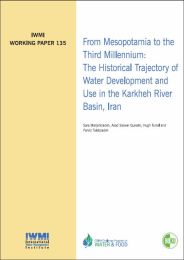From Mesopotamia to the Third Millennium: The Historical Trajectory of Water Development and Use in the Karkheh River Basin, Iran.
Citation:
Marjanizadeh, S.; Qureshi, A. S.; Turral, H.; Talebzadeh, P. 2009. From Mesopotamia to the third millennium: the historical trajectory of water development and use in the Karkheh River Basin, Iran. Colombo, Sri Lanka: International Water Management Institute. 51p. (IWMI Working Paper 135) [doi:10.3910/2010.206]
Abstract
The Karkheh River Basin is the third largest basin in Iran after Karoon and Dez, and occupies a strategic position on the western boundary of the country. The basin has seen remarkable ancient feats of engineering, and has a long history of wheat and barley production, complemented by horticulture. With the growth of the modern nation-state of Iran, water development has progressed steadily in tandem with rising populations and urbanization. The report aims to understand the historical setting and present situation of water development and allocation, in relation to rural development and agrarian policy. It provides the contextual backdrop for further research on the management of water to improve livelihoods in the basin through integrated and sustainable management of land and water resources. It provides further information on the changes in surface flows out of the component subbasins and looks at the development, use and consequences of groundwater abstraction.


